The AMD Ryzen 3 3300X and 3100 CPU Review: A Budget Gaming Bonanza
by Dr. Ian Cutress on May 7, 2020 9:00 AM EST*We are currently in the middle of revisiting our CPU gaming benchmarks, but the new suite was not ready in time for this review. We plan to add in some new games (Borderland 3, Gears Tactics) and also upgrade our gaming GPU to a RTX 2080 Ti.
Gaming: Ashes Classic (DX12)
Seen as the holy child of DirectX12, Ashes of the Singularity (AoTS, or just Ashes) has been the first title to actively go explore as many of the DirectX12 features as it possibly can. Stardock, the developer behind the Nitrous engine which powers the game, has ensured that the real-time strategy title takes advantage of multiple cores and multiple graphics cards, in as many configurations as possible.
As a real-time strategy title, Ashes is all about responsiveness during both wide open shots but also concentrated battles. With DirectX12 at the helm, the ability to implement more draw calls per second allows the engine to work with substantial unit depth and effects that other RTS titles had to rely on combined draw calls to achieve, making some combined unit structures ultimately very rigid.
Stardock clearly understand the importance of an in-game benchmark, ensuring that such a tool was available and capable from day one, especially with all the additional DX12 features used and being able to characterize how they affected the title for the developer was important. The in-game benchmark performs a four minute fixed seed battle environment with a variety of shots, and outputs a vast amount of data to analyze.
For our benchmark, we run Ashes Classic: an older version of the game before the Escalation update. The reason for this is that this is easier to automate, without a splash screen, but still has a strong visual fidelity to test.
Ashes has dropdown options for MSAA, Light Quality, Object Quality, Shading Samples, Shadow Quality, Textures, and separate options for the terrain. There are several presents, from Very Low to Extreme: we run our benchmarks at the above settings, and take the frame-time output for our average and percentile numbers.
All of our benchmark results can also be found in our benchmark engine, Bench.
| AnandTech | IGP | Low | Medium | High |
| Average FPS | 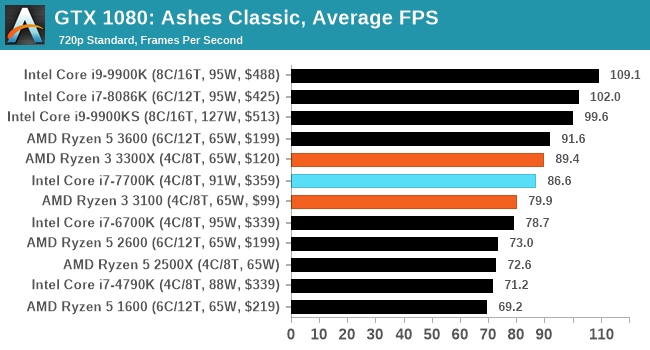 |
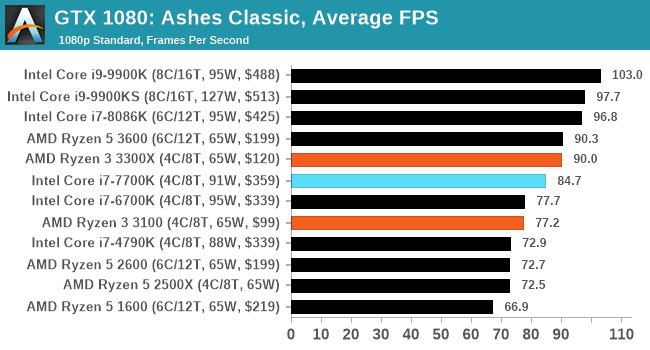 |
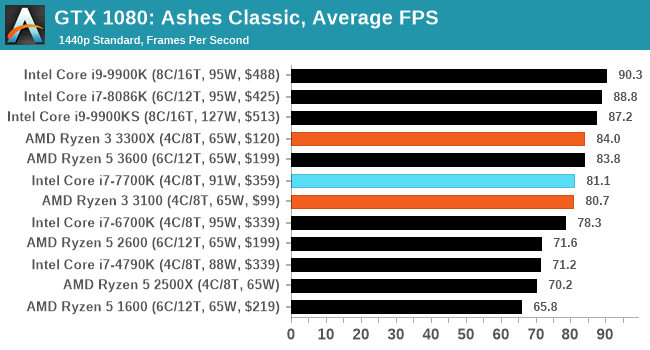 |
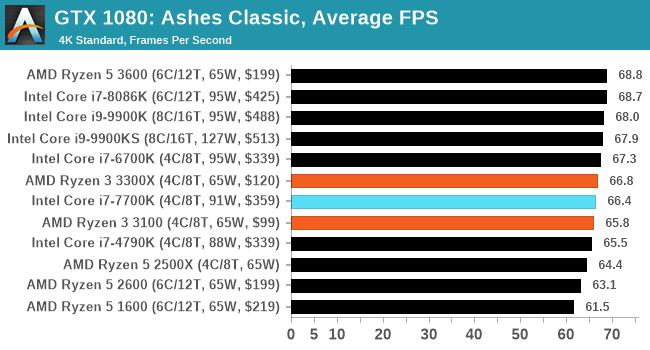 |
| 95th Percentile |  |
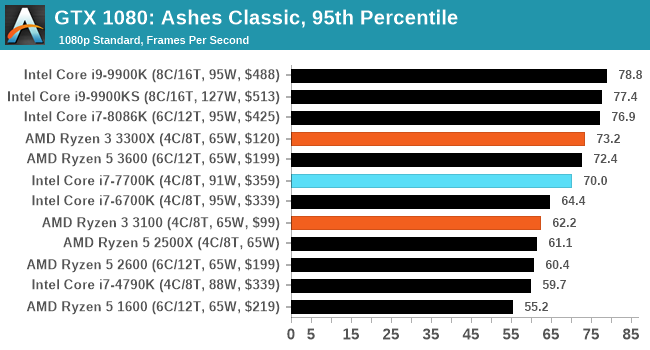 |
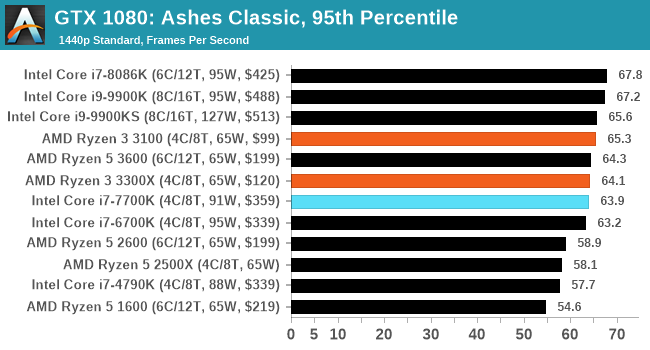 |
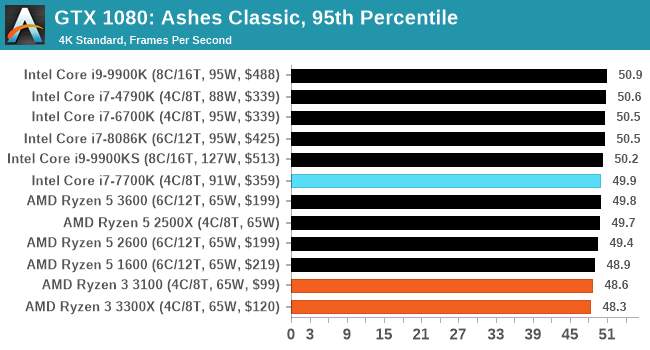 |


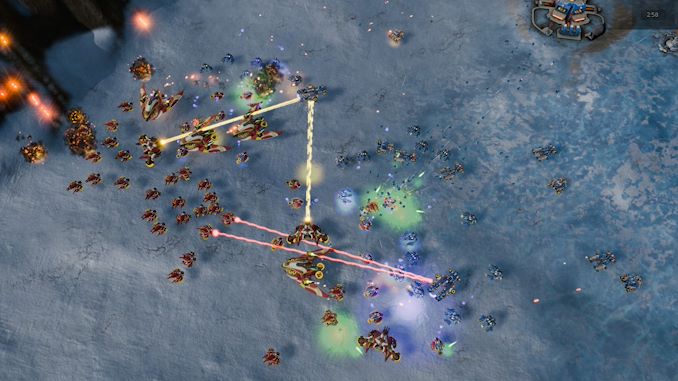









249 Comments
View All Comments
Ian Cutress - Thursday, May 7, 2020 - link
4790K 6700K 7700KAll Intel quad core showing generational differences as to where the 3300X and 3100 fit in.
1600X, 1700, 1700X, 1800X are all in our benchmark database, Bench.
It's practically listed on almost every page.
notb - Thursday, May 7, 2020 - link
And that's obviously great. But with that approach you could just write "3100 and 3300X added to Bench", right? :)I have nothing against the factual layer of this article. Results are as expected and they look consistent.
But it's essentially a story how an entry-level $120 CPU from company A beats a not-so-ancient flagship from company B.
So I'm merely wondering why you decided to write it like this, instead of comparing to wider choice of expensive CPUs from 2017. Because in many of your results 3300X beats 1st gen Ryzens that were even more expensive than the 7700K.
Or you could include older 4C/8T Ryzens (1500X) - showing how much faster Zen2 is.
Instead you've included the older 6-core Ryzens, which are neither similar in core count nor in MSRP.
Ian Cutress - Friday, May 8, 2020 - link
2600/1600 AF is ~$85 at retail (where you can find it), and judging by the comments, VERY popular. That's why this was included.Deicidium369 - Friday, May 8, 2020 - link
Just say AMD GOOD! INTEL BAD! that's all they are looking foreastcoast_pete - Thursday, May 7, 2020 - link
Some other sites have, and yes, the 3300 gives most of the 1st generation Ryzens a run for their money.Irata - Thursday, May 7, 2020 - link
This is a highly impressive little CPU for the money.I particularly liked the 3300X‘s good showing. If this is at least in part due to it using only one CCX, this should bode well for Ryzen 3 which should have an eight core CCX.
Look at some tests were Ryzen did not do so well wrt their Intel counterpart like Kraken and Octane - the 3300x now does very well. It even scores slightly better than the 3700x
wr3zzz - Thursday, May 7, 2020 - link
Does the B550 MB need active cooling? I can't tell from the pic.callmebob - Thursday, May 7, 2020 - link
Look at the spec graphics. Note the only difference to the old B450 is pretty much that it provides PCIe 3.0 lanes instead of PCIe 2.0.Now, when was the last time you saw a PCIe 3.0-based chipset hub needing active cooling?
As an aside, while i am kinda glad the B550 is finally coming, i am also a bit disappointed in seeing AMD (and their design/manufacturing partners) needing a better part of a year just for managing a bump from PCIe 2.0 to PCIe 3.0. PCIe 3.0 has been in the market for around eight years now; there is no excuse for AMD taking this long to figure out this s*it.
Fritzkier - Thursday, May 7, 2020 - link
Because their PCIe 3 and 4 was provided by the CPU tho. Or maybe there's an advantage of PCIe lanes provided by the chipset?callmebob - Thursday, May 7, 2020 - link
Haha, do you even know _how many_ PCIe lanes the CPU provides? Wager a guess whether it is for more than a single x16 slot?